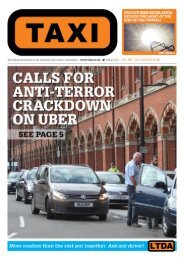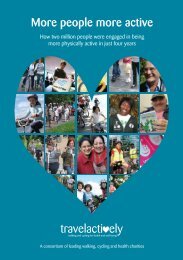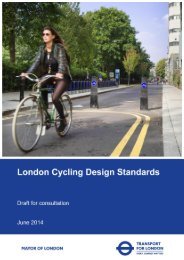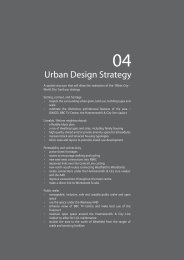Travel in London Travel in London
travel-in-london-report-8
travel-in-london-report-8
You also want an ePaper? Increase the reach of your titles
YUMPU automatically turns print PDFs into web optimized ePapers that Google loves.
8. Transport connectivity, physical accessibility and understand<strong>in</strong>g <strong>London</strong>’s diverse communities<br />
<strong>Travel</strong> behaviour<br />
This section looks at aspects of travel behaviour by <strong>London</strong>’s diverse communities, draw<strong>in</strong>g<br />
on TfL’s <strong>London</strong> <strong>Travel</strong> Demand Survey over the past ten years of available data (see also<br />
chapter 11 of this report).<br />
In terms of trip rates (the average number of trips made per person per day), women<br />
make the highest average number of trips per day and older people tend to make a<br />
lower number, followed by people on low <strong>in</strong>comes and younger people (figure 8.9).<br />
The relative number of trips made by each group is <strong>in</strong>formative, with disabled<br />
people mak<strong>in</strong>g, on average, 32 per cent fewer trips per person per day than the<br />
population as a whole. While overall trip rates have varied, reflect<strong>in</strong>g factors such as<br />
the economic recession at the end of the last decade, as well as an apparent<br />
decl<strong>in</strong>e <strong>in</strong> the most recent year, the relativity between the groups <strong>in</strong> terms of trip<br />
mak<strong>in</strong>g has been remarkably stable. It is worth not<strong>in</strong>g that although women make a<br />
higher number of trips, they tend to be shorter. This is likely to be due to ‘trip<br />
cha<strong>in</strong><strong>in</strong>g’ where several small trips are l<strong>in</strong>ked together.<br />
Figure 8.9<br />
2.8<br />
Overall trip rates for an average day by equality group.<br />
2.6<br />
Trips per person per day<br />
2.4<br />
2.2<br />
2.0<br />
1.8<br />
1.6<br />
2006/07 2007/08 2008/09 2009/10 2010/11 2011/12 2012/13 2013/14 2014/15<br />
Under 25s Over 64s HH <strong>in</strong>come less than £20,000 Women BAME Disabled All <strong>London</strong>ers<br />
Source: TfL Plann<strong>in</strong>g, Strategic Analysis.<br />
Table 8.6 shows the frequency with which different groups use the different forms of<br />
transport. Walk<strong>in</strong>g is the most frequently used form of transport for all <strong>London</strong>ers. Almost<br />
all <strong>London</strong>ers walk (<strong>in</strong> terms of mak<strong>in</strong>g a recordable walk trip <strong>in</strong> the LTDS survey) every week<br />
(96 per cent). Disabled <strong>London</strong>ers are less likely to walk at least weekly (78 per cent) and<br />
almost all younger <strong>London</strong>ers walk at least once a week <strong>in</strong> <strong>London</strong> (99 per cent).<br />
The bus is the next most frequently used type of transport <strong>in</strong> <strong>London</strong>: 61 per cent of<br />
<strong>London</strong>ers use it at least once a week. Younger <strong>London</strong>ers are the most likely equality group<br />
154 <strong>Travel</strong> <strong>in</strong> <strong>London</strong>, Report 8








